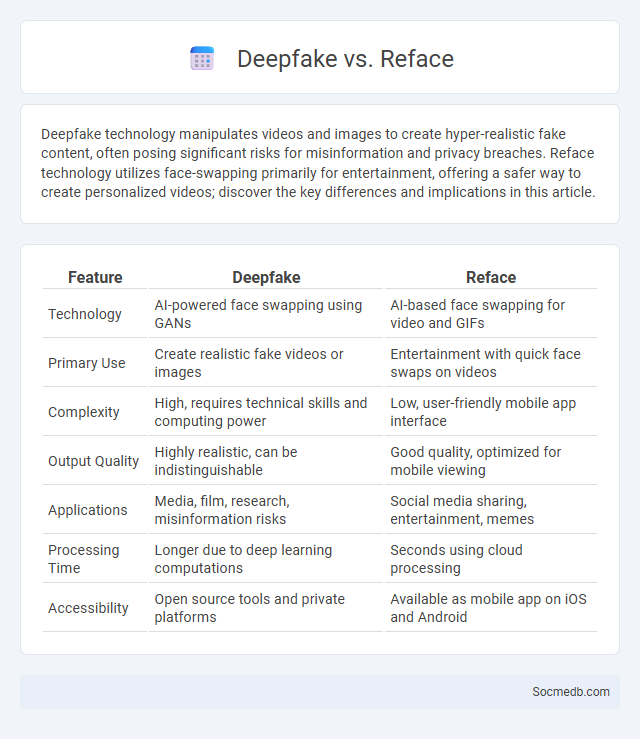
Photo illustration: Deepfake vs Reface
Deepfake technology manipulates videos and images to create hyper-realistic fake content, often posing significant risks for misinformation and privacy breaches. Reface technology utilizes face-swapping primarily for entertainment, offering a safer way to create personalized videos; discover the key differences and implications in this article.
Table of Comparison
| Feature | Deepfake | Reface |
|---|---|---|
| Technology | AI-powered face swapping using GANs | AI-based face swapping for video and GIFs |
| Primary Use | Create realistic fake videos or images | Entertainment with quick face swaps on videos |
| Complexity | High, requires technical skills and computing power | Low, user-friendly mobile app interface |
| Output Quality | Highly realistic, can be indistinguishable | Good quality, optimized for mobile viewing |
| Applications | Media, film, research, misinformation risks | Social media sharing, entertainment, memes |
| Processing Time | Longer due to deep learning computations | Seconds using cloud processing |
| Accessibility | Open source tools and private platforms | Available as mobile app on iOS and Android |
Introduction to Deepfake and Reface Technologies
Deepfake technology leverages advanced artificial intelligence algorithms, particularly generative adversarial networks (GANs), to create hyper-realistic synthetic media that can convincingly replace faces or voices in videos and images. Reface technology, a popular application of deepfakes, enables users to swap faces in photos or videos instantly, enhancing entertainment and social media engagement by creating personalized, shareable content. These innovations raise significant discussions around digital identity, privacy, and the ethical implications of manipulated media in the rapidly evolving social media landscape.
How Deepfake Works: AI Behind the Illusion
Deepfake technology uses advanced AI algorithms, particularly deep learning and neural networks, to create hyper-realistic fake videos by manipulating facial expressions and voice patterns. Your social media content can be convincingly altered through generative adversarial networks (GANs), which train two models to continuously improve the realism of the synthetic media. Understanding this AI-driven process is crucial for identifying deepfakes and protecting your digital identity online.
Reface App: Features and Functionality
Reface App leverages advanced AI technology to deliver realistic face-swapping and deepfake capabilities, allowing users to seamlessly transform their selfies into popular characters or celebrities. Its intuitive interface supports GIF and video edits, real-time face tracking, and a vast library of templates, enhancing user engagement and creativity. Your social media content gains a dynamic edge with Reface's high-quality animations, making it a leading tool for viral visual storytelling.
Deepfake vs Reface: Key Differences
Deepfake technology uses AI algorithms to create highly realistic but digitally manipulated videos or images by swapping faces, often making it difficult to distinguish fake content from real, which poses significant risks to social media authenticity and privacy. Reface, in contrast, is an app-focused tool designed primarily for entertainment purposes, allowing users to swap their faces onto celebrities or movie characters quickly with a user-friendly interface and less sophisticated AI, resulting in short, shareable clips. The key difference lies in Deepfake's complex AI-driven fabrication aimed at deception or misinformation, whereas Reface emphasizes fun and social engagement without malicious intent.
Use Cases: Entertainment, Education, and Beyond
Social media platforms revolutionize entertainment by providing instant access to videos, music, and live streaming, engaging millions of users daily. Educational institutions leverage social media for interactive learning, virtual classrooms, and peer collaboration, enhancing knowledge retention and accessibility. Your ability to connect, share, and learn through social media extends far beyond entertainment, offering powerful tools for personal growth and professional development.
Ethical Implications of Deepfake and Reface
Deepfake and Reface technologies pose significant ethical challenges by enabling the creation of highly realistic but fabricated media that can mislead and manipulate public perception. Your digital identity and privacy may be at risk as these tools can be used for identity theft, misinformation campaigns, and unauthorized content creation. Understanding these implications is crucial for promoting responsible use and developing strategies to detect and combat harmful deepfake content on social media platforms.
Risks and Dangers: Misinformation and Privacy
Social media platforms often expose users to widespread misinformation, which can distort facts, influence opinions, and contribute to the spread of false narratives. Privacy risks arise as your personal data might be collected, shared, or exploited without consent, leading to potential identity theft, targeted advertising, or unauthorized surveillance. Vigilance and understanding of platform policies are crucial to protecting your digital security and maintaining the integrity of information you encounter.
Detection and Prevention Methods
Advanced detection and prevention methods for social media leverage machine learning algorithms to identify and mitigate harmful content, such as hate speech, misinformation, and cyberbullying. Real-time monitoring systems analyze text, images, and videos for policy violations while employing natural language processing (NLP) to understand context and intent. Multi-factor authentication, user behavior analysis, and automated content filtering play critical roles in preventing unauthorized access and the spread of malicious activities on social networks.
Future Trends in Face-Swapping Technology
Face-swapping technology is rapidly evolving with advancements in artificial intelligence and deep learning, enabling more realistic and seamless digital transformations. Your interaction with social media platforms could be transformed as these future trends simplify content creation and enhance personalized experiences through real-time face swaps in videos and images. Emerging privacy concerns and ethical considerations will also shape how face-swapping tools are regulated and implemented across social media ecosystems.
Conclusion: Choosing Between Deepfake and Reface
Choosing between deepfake and Reface depends on ethical considerations, intended use, and technological sophistication. Deepfake technology offers high-quality manipulation but raises significant privacy and misinformation concerns, while Reface provides user-friendly face-swapping with less ethical risk. Businesses and individuals must evaluate the balance between creativity, authenticity, and responsibility when selecting these social media tools.
 socmedb.com
socmedb.com